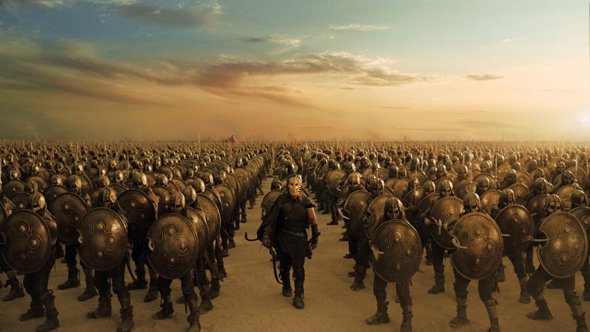In the background, in the aftermath of a horrific battle, uniformed men unload caskets from a truck. Philip Strub had to tut as he read the description.
“That’s not how we do things,” the director of the Pentagon’s Entertainment Media office recalls telling film makers preparing to incorporate that scene into a movie. “Caskets aren’t just cargo. We always move them with full honors.”
Strub was pleased when the director got the message, and the fallen warriors were treated with white gloves and respect. That was more than they’d gotten from their robot-monster killers, of course.
That’s the nature of Strub’s role at the office that oversees the military’s relationship with the American movie industry, a department that dates to the year the first Hollywood studio opened and is far older than the Pentagon building itself.
Strub laughingly describes the relationship as “mutually exploitive.” Certainly, it’s one that American moviegoers see all the time. The Pentagon doesn’t keep statistics, but private counts put the number of movies the Department of Defense has supported above 1,000.
This relationship became very public and deeply partisan earlier this year, when some Republicans in Congress accused the Obama administration of giving special favors to Oscar-winning director Kathryn Bigelow’s upcoming “Zero Dark Thirty,” which tells the story of the mission to kill Osama bin Laden.
The accusation was that the administration granted unusual access in the hope that the film, now expected to be released in December, would boost President Barack Obama’s re-election bid, including meetings with Undersecretary of Defense for Intelligence Michael Vickers. The Pentagon confirms the meetings but says there was nothing unusual or improper in them. House Homeland Security Committee Chair Rep. Peter King, R-N.Y., says he’s still concerned that the filmmakers got “special access” to “sensitive information” on a secret mission.
“I am still awaiting the conclusion of the ongoing Department of Defense and CIA inspector general investigations that I requested,” he said.
Strub points out that meetings with filmmakers aren’t exactly rare. In fact, “Zero Dark Thirty” didn’t get official Pentagon support. Bigelow got some information, but others get much more. The practice of supporting films is so ingrained that the Pentagon even has a price list online for military hardware leased out to approved films.
An hour’s rental of an airborne command post – which in the event of nuclear war would serve as Air Force One – costs $72,000 for a movie the Pentagon wants to support. A B-1B long range bomber costs $50,529 an hour, and an F-16 fighter goes for $10,181 an hour. The budget-minded could rent a training glider for as little as $89 an hour. The rates include the wages of the military personnel involved in flying the planes. Tom Cruise would have been allowed to climb into jet cockpits in the 1986 film “Top Gun,” but he wasn’t allowed to fly the fighters.
Strub’s job is to nudge an industry devoted to fantasy and fiction toward an odd sort of cinema verite. He and others in his department pore over scripts of television shows such as “Hawaii Five-0,” even on weeks when the show isn’t featuring anything military in nature. That way, they can be familiar enough with the characters that when they make suggestions in the future , they’ll be able to fit them into the way a show works.
Most of Strub’s work is with feature films. His push for a change in the way military dead were handled came in the filming of “Transformers” – or maybe the sequel, he isn’t quite sure. This summer, audiences can spot similar bits of military-approved detail in films about war with space aliens (“Battleship”) and by superheroes against other worldly gods (“The Avengers”).
Before the 1960s, film historian Lawrence Suid said, virtually every American film about the U.S. military had official support, which ran from advice on a script to the use of military hardware and installations.
“What do the movies get from the Pentagon? Uniforms,” Suid said, half-joking. As for how the Pentagon benefits from movies, he wrote in the book “Guts and Glory,” “recruiting, as well as their efforts to inform the public and Congress of their activities.”
The effectiveness of movies as a recruiting tool has never been quantified, but Suid notes that film helped each branch of service rehabilitate its tattered image after Vietnam. And it’s no accident that many of the movies the Department of Defense supports are blockbusters, which attract teenagers, many of them approaching or at the age at which they can volunteer for service.
Strub emphasizes that what he pushes for is an accurate portrayal of the military, not a sugarcoated one.
As evidence, he notes the Pentagon’s willingness to support a movie – as yet unmade – about the My Lai massacre in Vietnam, in which U.S. troops killed hundreds of apparently unarmed civilians, and the trial that followed.
The first example of cooperation between the film industry and the military came in 1911, when director William Humphrey convinced Lt. Henry Arnold to fly his biplane in front of a camera for “The Military Air-Scout.” By 1927, the relationship had helped create the movie “Wings,” the winner of the first Academy Award for best picture.
The importance of supporting films has increased with the advent of the all-volunteer military, Strub thinks.
“In World War II, virtually every American had a friend or relative in the service,” he said. “That’s not the case today. A much smaller percentage of the country has a direct tie to the military, so for many Americans what they learn about the services comes through film. It’s important that be an accurate portrayal.”
Some classic films were rejected for official support, such as “The Deerhunter” and “Apocalypse Now,” both of which had an anti-war message, and “It’s a Wonderful Life,” the 1946 tale of a small-town banker contemplating suicide that’s become a Christmas season staple on television.
The list of films that received support would be familiar to most moviegoers, running from the obvious to the not-so-obvious: “Top Gun,” “The Killing Fields,” “Judgment at Nuremberg,” “From Here to Eternity,” “Jurassic Park III,” “Invaders From Mars” and “It Came From Beneath the Sea.”
“We could never hope to buy that level of exposure,” Strub said.
Read more here: http://www.thenewstribune.com/2012/08/08/2249124/pentagon-gets-us-military-ready.html#storylink=cpy


